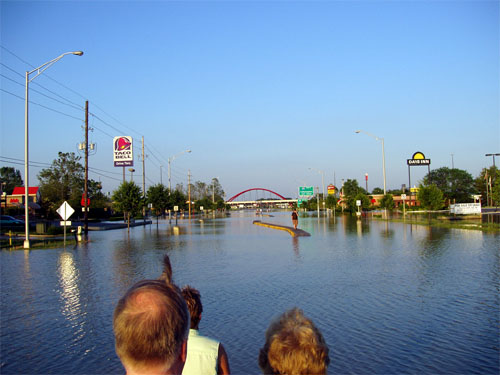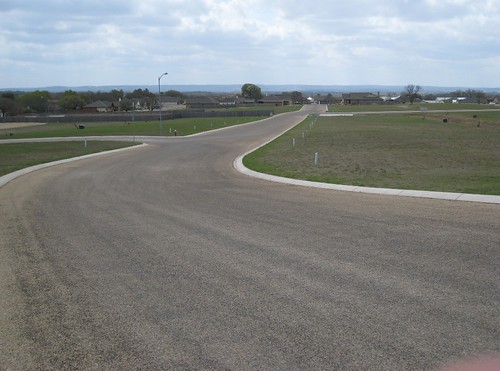Before the (next) deluge: Midwestern floods remind us of sprawl's toll

Posted April 24, 2013 at 1:32PM
As I write, places like Clarksville, Missouri and Grand Rapids, Michigan are under water, having been hit by severe rains and consequent flooding over the last week. “The worst flood in recorded history” was the phrase used by one community spokesperson when I turned on the TV news this morning. The situation is similar all over the upper Midwestern US and down the Mississippi River basin.
Doyle Rice reports in USA Today:
“As of Tuesday morning, more than 150 gauges were in flood stage across the USA, almost all of them in the upper Midwest, according to the weather service. This included 37 at ‘major’ flood stage. Major flood stage means there will be ‘extensive inundation of structures and roads, and that significant evacuations are likely,’ according to the weather service.
“Caused by the extremely heavy rain that fell last week, the surge of high water is slowly making its way down the Mississippi and Illinois rivers and their tributaries, according to Steve Buan, a hydrologist with the North Central River Forecast Center in Chanhassen, Minn.”
One of the culprits in major flooding is sprawling land development. Stay with me on this.
Does suburban sprawl – spread-out, automobile-dependent strip malls, big-box stores, wide arterial roadways, and unending large-lot housing – cause flooding? Absolutely not. (Sprawl doesn’t make it rain, although I can put together a very plausible theory about increased driving, tailpipe emissions, global warming, and severe weather events.) But does sprawl aggravate flooding? Oh, yeah. Here’s how:
When it rains, the water needs somewhere to go. Ideally, that someplace is a forest or meadow, which filters and absorbs the water into the ground. But when, instead of natural vegetation, we have rooftops and pavement, the natural process is broken and the water runs off, gaining volume and velocity. If the rainfall is hard enough and/or steady enough, flooding occurs; and floodwaters increase as runoff increases. Nature, already overburdened by severe precipitation, is prevented entirely from doing its job at limiting the accumulation of flood waters when impervious surface is in the way.
What does this have to do with suburban sprawl? Spread-out, low-rise development contributes more rooftops and pavement per unit of development to the watershed than do walkable neighborhoods. Imagine a 200,000-square-foot, one-story Walmart Supercenter surrounded by 15-20 acres of surface parking. When it rains on Walmart's property, there’s no way the water can get into the ground through naturl filtration processes. Now multiply that by all the other parking lots required for strip malls and office parks, and all the widened and extended road surfaces needed to accommodate traffic heading to the retail and spread-out housing.
Now imagine a different scenario: The same amount of floor space is accommodated by a combination of even two- to four-story buildings, and housing built more compactly to a walkable scale. Imagine that the pattern reaches sufficient critical mass to support decent transit service and the substitution of walking, bicycling, and transit use for some of those car trips, thus reducing the amount of road surface needed. Where there is parking, imagine that some of it, rather than spread out on surface lots, is placed in multi-story, above- or below-ground garages such as those found in urban areas. With rainwater hitting a smaller footprint of pavement and other hard surfaces, there is less runoff.
Would the difference be great enough to prevent flooding altogether during the most severe weather events? Probably not. But it could make a difference in the volume of water running off into the flood.
EPA has done some calculations on the residential part of the issue. Suppose your metropolitan area is going to grow by 10,000 homes over the next several years. If those homes are built one to an acre, a hypothetical storm might produce 187 cubic meters of runoff; but reducing the watershed coverage to an average of four homes per acre, the runoff from those same new homes would be reduced to 62 cubic meters. Build the homes at eight to an acre, and the runoff would reduce further, to 49.5 cubic meters. The main reason for the difference is the amount of roadway required to service the homes is much greater at low densities than at moderate densities.
The effects will not always be felt the most severely where the sprawl is located. Because of what Lee Epstein calls "the Plumbers' Law," water flows downstream. This means that impervious surface upstream in a watershed can contribute volume to low-lying places farther downstream, such as Clarksville and Grand Rapids. It helps to think of the watershed as a whole: for a given population, the more spread-out the devlopment footprint in the watershed, the more total runoff flowing downstream.
In addition to exacerbating rainfall events, sprawl also ironically exacerbates drought, both by typically requiring more water consumption and (again) by worsening runoff, preventing the absorption of precipitation that could recharge groundwater supply.
In both cases, the response for more resilience to severe weather events should include the adoption of at least two things: (1) better planning for growth patterns that reduce pavement, and (2) green infrastructure to absorb more rainwater before it becomes runoff. As I’ve written before, techniques such as bioswales, pervious pavement in appropriate places, and green roofs mimic nature and allow water to be absorbed even where there is development. They also reduce summer heat and bring more nature into communities, good things for all. For an in-depth discussion of green infrastructure and what some big cities are doing to adopt it (unfortunately, few suburbs are, and that’s a problem), read the extensive report on the subject developed by my colleagues at NRDC.
It’s time to get more resilient.
On point, here’s Jackson Browne singing his environmental masterpiece, “Before the Deluge”:
Related posts:
- Sandy as preview: making communities more resilient to severe climate events (with Lee Epstein) (November 5, 2012)
- How sprawl worsens the impacts of drought and how smart growth can help (July 19, 2012)
- The Plumbers' Law, or how sustainable development helps watersheds (by Lee Epstein) (June 11, 2012)
- Nine low-tech steps for community resilience in a warming climate (March 22, 2012)
- Report highlights exemplary clean water practices in Philadelphia, Milwaukee, other cities (November 17, 2011)
- Watershed benefits of smart growth duplicate transportation benefits, according to recent research (June 1, 2010)
- How smart growth protects watersheds, and how green infrastructure can make it even better (March 20, 2009)
Move your cursor over the images for credit information.


